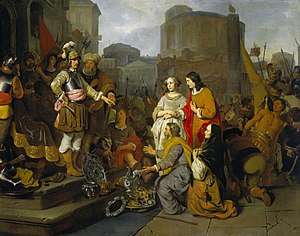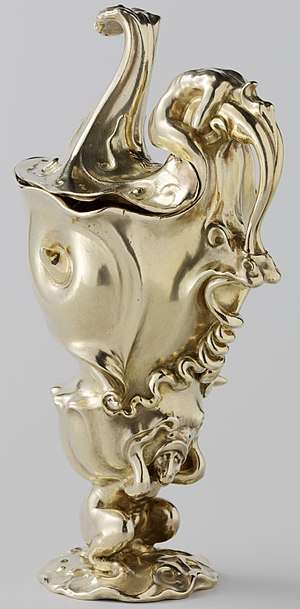The Continence of Scipio (Gerbrand van den Eeckhout)
The Continence of Scipio (Dutch: De grootmoedigheid van Scipio) is a circa 1653 painting by Dutch artist Gerbrand van den Eeckhout. It shows the continence of Scipio and is now in the collection of the Rijksmuseum in Amsterdam.
| The continence of Scipio | |
|---|---|
 | |
| Artist | Gerbrand van den Eeckhout |
| Year | c. 1653 |
| Medium | oil paint, canvas |
| Dimensions | 133.0 cm (52.4 in) × 168.0 cm (66.1 in) |
| Location | Rijksmuseum, Netherlands |
| Accession No. | SK-C-1631, NK2276, NK2276 |
| Identifiers | RKDimages ID: 2713 |
Description
The painting shows the moment when Scipio informs the groom that he can have his bride, as well as the riches that the bride's parents have just paid in ransom. Of the riches displayed, the ewer of the Amsterdam silversmith's guild, a famous silver object by Adam van Vianen, is also in the Rijksmuseum collection. Van den Eeckhout made another version of the same subject, that also features the ewer (lying on its side), which is now in the collection of the Toledo Museum of Art:
 Toledo version
Toledo version The ewer
The ewer
This painting is one of several paintings in the collection of art dealer D. Katz that were taken to the Führer museum in Linz. After WWII it was returned with other Nazi looted art to the Netherlands and has been on loan to the Rijksmuseum since. In 1966 it was noticed by the silver curator of art in the museum, Theresia M. Duyvené de Wit Klinkhamer, who included it in her overview of paintings that show the Adam van Vianen ewer.[1]
References
- Th.M. Duyvené de Wit-Klinkhamer, 'Een vermaarde zilveren beker', Nederlands Kunsthistorisch Jaarboek 17 (1966), p. 92